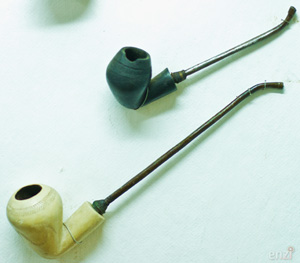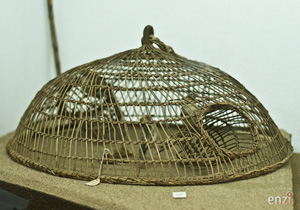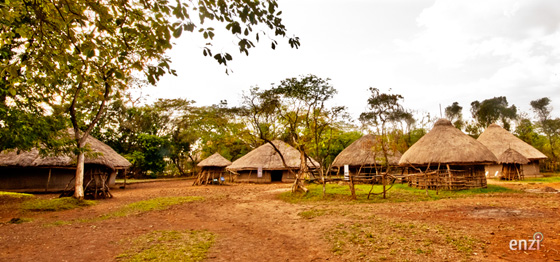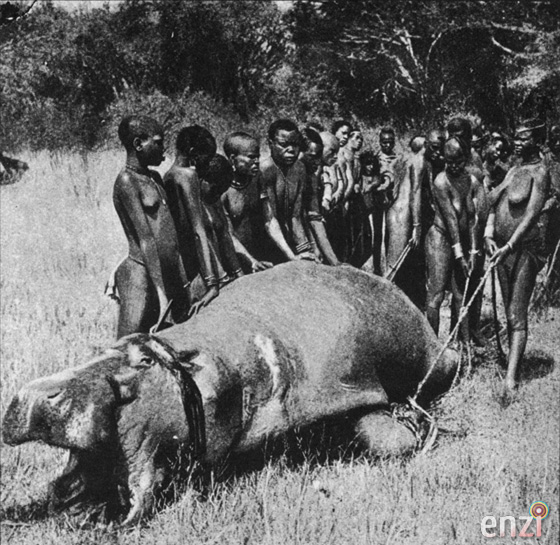River-Lake Nilotes – The Luo
Language:Dholuo. Alternate names: Kavirondo Luo, Luo, Nilotic Kavirondo. Dholuo is different from Lwo of Uganda or Lwo of Sudan and is also spoken in Tanzania.

Luo tobacco pipe
Language family: Nilo-Saharan, Eastern Sudanic, Nilotic, Western, Luo, Southern, Luo-Acholi, Luo.
Origins of the community: The Luo are a Nilotic group of people who migrated from Bahr-el-Ghazal in Southern Sudan, and settled in the western part of Kenya in areas around Lake Victoria. They arrived into this part of East Africa from as early as the 15th century to the 19th century. They arrived in various groups:
- The Joka Jok arrived in the 15th century and settled at Ramogi hill, Sakwa, Asembo and Alego.
- The Joka Owiny led by Owiny Sigoma came in the 17th century and settled around Kisumu, Nyakach and South Nyanza.
- The Joka Omolo came into Kenya from Busoga in Uganda in the 18th century. They settled in Samia, Yimbo, and South Nyanza where they joined the group that had arrived earlier.
- The last group to arrive was the Luo-Abasuba who arrived from Uganda in the 19th century, and settled in Rusinga and Mfangano islands in Lake Victoria. They are a mixture of Bantus and Luos.
The Luo probably originated at Wau in southern Sudan, near the confluence of the Meride and Sue Rivers. The Luo migrated into western Kenya via today’s eastern Uganda, the first wave arriving sometime around 1500AD.
The Luo were the first settlers in western Kenya. They supposedly moved south after 1000C.E. from the Nile region, through Sudan, arriving in Uganda by the early 1400s, and then what is now Kenya by the late 1400s and 1500s.
Population: According to the 2009 Kenya population and households census results the Luo number 4,044,440.
The Luo are the third largest ethnic group (13%) in Kenya, after the Kikuyu (22%) and the Luhya (14%). The Luo population was estimated at 4.1 million in 2010.
Geographical location of the community:After their last migration, the Luo settled in Nyanza Province. They occupy parts of the eastern shore of Lake Victoria and areas to the south.

Luo bird trap
The Luo live along Lake Victoria from Homa Bay in the south to Sio Port, close to the Uganda border in the north.
The Luo live in the central and south of Nyanza Province that lie astride the Equator around the Winam Gulf of Lake Victoria. The Luo homeland is bounded on the west by Lake Victoria, whose altitude is more than 1,000m above sea-level. To the north of Winam Gulf they occupy the landscape rising from 1,000m near the Lake to about 1,500m at the foot of the Nandi escarpment. To the south of the Gulf is the plateau region of Karachuonyo and Kabondo from which several Luo groups migrated round the Gulf to central Nyanza. The Kuja basin, which slopes westwards from the Kanyamkago hills to Kanyamwa escarpment on the eastern side of Lambwe valley to the Kuja River is also occupied by the Luo.
Housing: The first wife’s house and granary are located prominently at the back of the homestead opposite the main gate. Subsequent wives have homes alternatively to her right and left in the order of their marriage. Sons are provided with homes adjacent to the main gate of the compound in the order of their birth. The husband’s hut is located near the centre of the compound. If his brothers have not formed their own homesteads, they reside on the edge of the compound near its centre.

Luo homestead at Kisumu museum
A traditional Luo hut was made of mud and wattle (woven twigs) walls with a thatched roof. The huts were circular in shape, as was the homestead.
Economic activities: At the time of migration to western parts of Kenya, the Luo were cattle-herding pastoralists, who then adopted fishing after settlement. They are also agriculturalists, raising subsistence and cash crops, particularly sugar.
The primary grain crops include maize, millet and sorghum, while cassava and sweet potatoes are the major root crops. Sorghum and cassava are especially valued for their resistance to drought. Bananas are grown in the higher elevation areas. Cash crops include tobacco, cotton, sunflowers, coffee, peanuts and sugar cane. They rear sheep, goats, chickens, and cattle which are used to pay bride wealth.
Fish and Ugali are the staple foods of the Luo tribe.
Trade: Garden produce was exchanged for animals, handicrafts, pots and baskets.
Cycles of life
Naming: ‘Nyathi ma wedo’ is the Luo equivalent of newborn child. The child is named immediately after birth. The name is drawn from the time of day that the child is born e.g. dawn, morning, midday, evening, night, etc. For example, a male-child born at night is called Otieno, while the girl is called Atieno. The first letters ‘O’ and ‘A’ denote the masculine and feminine genders respectively.
The naming ceremony is called juogi, and is the first major ritual in a Luo person’s life. Between the child’s birth and age two, it is said that an ancestor appears in a dream to an adult member of the family. The Luo believe that only people who did good things when alive appear in this way and are thus “reincarnated” while evil people are permanently gone. The child is supposed to assume some of the mannerisms of the ancestor he or she is named after.
Education: Traditionally, Luo stories were recited in the siwindke, the house of the widowed grandmother. An old woman would share the oral history of the clan, with the Luo boys and girls who gathered to sleep and be taught the ways and beliefs of their society.
Girls spent time in peer groups where conversation centred on boys and their personal attributes. In traditional Luo society, sex education was in the hands of older women who gave advice in a communal sleeping hut used by teenage girls.
Initiation: The Luo do not practice the ritual circumcision of males as initiation. Instead, children formerly had their six lower front teeth removed at an initiation ceremony. This ritual has largely fallen out of use. Until the 1970s it was a common practice to extract six lower front teeth at some point in the pre-adult phase of the life cycle. The Luo did not adopt circumcision for men, as practised in some neighbouring Bantu groups. Adolescence is a time of preparation for marriage and family life. Traditionally, girls obtained tattoos on their backs and had their ears pierced.
Marriage: Traditionally, couples were introduced to each other by matchmakers, however, marriage among Luo at the moment is fast becoming westernised. The traditional marriage takes place in two parts, both involving the payment of a bride price by the groom. The first ceremony, the Ayie, involves the payment of money to the mother of the bride; the second stage involves giving cattle to her father. If the husband dies during the marriage, it is customary for the brother to act as a replacement.

Luo group hauling captured hippo.
The smallest social unit is the family, which is made of a man, his wife or wives, his sons and daughters, his sons’ wives and his grandchildren.
A newly wed bride’s activities at her matrimonial home are centred around her grandmother-in-law’s house to prepare her for the life ahead as a mother. She cooks from there and stays there for a couple of days then she goes to her house to start a family.
In traditional Luo society bride wealth was paid using iron hoes, later cattle was used, today it involves the payment of cattle and cash.
Death: Funerals last four days for a male and three days for a female. After the funeral of a man, a rooster (which symbolises masculinity to the Luo) is taken from his house and eaten by his relatives.
The Luo perform about fourteen ritual for one deceased. All the rituals are performed only when an elderly man dies, and a certain number of rituals are omitted depending upon the age, sex, and marital status of the deceased. The rituals are listed below:
- Death announcement
- Vigil (budho)
- Grave digging (kunyo)
- Burial (iko)
- Accompanying the spirit of the deceased to the former battleground (tero buru matin)
- Shaving (liedo)
- Mourner’s departure for their houses (kee)
- Serving a meal to the deceased and his family by married women (yaodhoot). Literally yaodhoot means ‘opening the door’ which implies that the survivors start their new life.
- Serving a meal to the deceased (tedo). On the day of the tedo the sons and daughters return to their natal home and cook for the dead mother or father.
- Going to the former battleground with the spirit of the deceased (tero buru maduong’)
- Visiting the widow’s natal home (tero cholla)
- Dividing articles left by the deceased (keyo nyinyo). Articles to be divided include clothes, furniture, dishes, calabashes, and cooking pots. Land and animals are divided among surviving sons not that day, but some other day.
- Remembrance (rapar)
- Serving a meal to the family of the deceased (budho)
The present day Kenya Luo traditionally consist of 26 sub-groups, each in turn composed of various clans and sub-clans ( “Jo-” indicates “people of”.):
- Jo-Gem
- Jo-Yimbo
- Jo-Ugenya
- Jo-Seme
- Jo-Kajulu
- Jo-Karachuonyo
- Jo-Nyakach
- Jo-Kabondo
- Jo-Kisumo (Jo-Kisumu)
- Jo-Kano
- Jo-Asembo
- Jo-Alego
- Jo-Uyoma
- Jo-Sakwa
- Jo-Kanyamkago
- Jo-Kadem
- Jo-Kwabwai
- Jo-Karungu
- Abasuba (Jo-Suna,Jo-Gwassi, Kaksingri, etc.)
- Jo-Kasgunga
- Jo-Kanyamwa
- Jo-Kanyada
- Jo-Kanyidoto
- Jo-Kamgundho
- Jo-Kamagambo
- Jo-Ramogi
